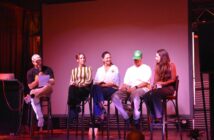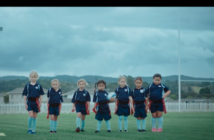As traditional boundaries around production and advertising start to blur, some of the more progressive companies are doing much more than just filming pretty pictures. Motion Sickness Studio, which kicked into gear in Dunedin around 18 months ago, is in that category. And now it’s moved north to try and get a slice of the content creation market in Auckland.
Founded by University of Otago students Sam Stuchbury, who studied marketing and graphic design, and Jon Thom, who studied fine arts, the pair’s first major project was a campaign for Dunedin Tourism that “profiled the whole vibe of the city” in video form and then followed it up with a number of profiles for the Insiders series.
Dunedin proved to be a great place to start the business, Stuchbury says, because it was big enough to get some decent work and small enough for everyone to see it.
“We’d never been to film school but we were always interested in design. Luckily that design background allowed us to compose shots well and we learned the technical stuff as we went along.”
Initially the focus was on video, as that’s where all the work was, but he says it’s increasingly doing projects that combine all of its skills (as its new website says: “Some call us creatives. Film makers. Late risers. Friday night rummers. Social strategists. Content creators. Designers. Photographers. Copy writers. Dreamers. Truth is, we’re a bit of all of ’em.”) And while he admits there’s a lot more competition in Auckland, whether it’s from advertising agencies, production companies or PR firms, the niche the company is exploring is the creation of content packages across online and social channels, something he says it can do more cost-effectively than its competitors.
“If it’s specifically for online you don’t need a ten person crew shooting on 4k [resolution]. Generally we’ll shoot on a crew of two, or three if stills are involved. And a lot of the videos we’re doing are for people who haven’t been in front of a camera before so a smaller crew means we get a more natural performance.”
One of its biggest clients is Emerald Foods, which controls the Movenpick, New Zealand Natural and Killinchy Gold brands in this market. It manages the day-to-day social media accounts for the brands and also creates content and social programmes. So in a way, it’s operating as a hybrid agency/production house (he points to a company called Alldayeveryday as an example of a content creation company it would be happy to emulate).
“Before they would’ve gone to an agency to conceptualise a campaign and then everyone is pulled together to make it happen. Now it’s all done inhouse. I think that’s going to be a big area of growth. Rather than having people coming to us and saying ‘can you produce a series of videos?’ they’re saying ‘do you have a concept for a social programme?’ and then we can create content within that.”
As an example of that, he points to its Killinchy Kitchen campaign, which asked fans to submit recipes created with the ice cream as an ingredient. That campaign idea has now been extended to cooking classes at a few high schools, and it’s also filmed a video with well-regarded cafe Little & Friday to promote the brand’s new Whittaker’s flavour.
While Motion Sickness Studio’s point of difference is that it can control a bigger chunk of the process for clients, he says it has also been brought on to work with agencies and is very open to collaboration.
Stuchbury didn’t want to talk specifics on revenue, but he says being able to support five full-time staff—three in Auckland and two in Dunedin, with extras brought in for bigger projects—after just a year-and-a-half in business is evidence of its success.
“I know Dunedin is growing really quickly [it does a lot of the web development down there], but I think the focus will be on social media and content up in Auckland … It’s only been the past six months that it’s felt like we’re earning a living and working properly rather than being a start-up. Before it was just getting a contract and then spending the money buying gear [it now owns a production quality fs700, studio drop and lighting and editing desktops].”
At the outset, he says their age held them back a bit because “we’d go into meetings and they’d see how young we were”.
“But now we’ve got the work behind us, we can justify what we’re doing so it’s become a bit of an advantage because clients want that young perspective and they like hearing our ideas.”
Also working in the company’s favour is the fact that clients generally seem to appreciate the need to be online and fish where the fish are.
“Internal marketing teams that might be a bit older are aware that it’s crucial to have a social media presence and have great content online, which is great for us as that’s where we’re operating and they’re putting budget aside for that side of the business.”
Many brands are finding out that building up a community on social platforms that can suddenly change the rules in an effort to pump up their profits can be a risky strategy. But the thing that underpins its work on social media, he says, is that there’s always a real world element to it.
“Killinchy is about experimenting with recipes and #Movenpicd [a Humans of New York-inspired street style photography campaign]is about taking photos in the store. That’s a big point of difference for our videos too. We hate cheesy stuff and we often turn down a lot of video work. We started up the company to try and do something a bit different, so we want to stay true to that.”
At first this principled stance limited them, but he’s pleased it stuck to its guns and now that clients can see its work is “real and powerful”, he says clients aren’t just giving them scripts to be filmed, they’re giving them briefs and trusting them to come up with ideas that meet them.
Other projects that stand out for Stuchbury include the sofa giveaway for Stolen Rum (it also took care of the photography), New Zealand Natural’s Get Adventurous series and Killinchy Gold’s Easter promotion on Facebook, which aimed to appeal to the foodies with some classy photography. Recently it’s also created content for Cadbury to promote the Jaffa race and its new café at Cadbury World in Dunedin, a video series for the Otago Rail Trail, which tells the stories of a few local characters, and a project for Tauranga-based furniture makers George and Willy that included a three-part video, still photography and a book to send to clients.
Like many production companies—and in keeping with the founders’ interests—it also dabbles in the arts, creating a slow-mo station to capture video at a friend’s gig (and then at a Resene party) and a few music videos, including one for Third3ye and another soon-to-be released clip for David Dallas’s new single, Southside, which was shot in South Auckland, features Mareko and Young Syd, and was a collaboration with JC Films.
“Thankfully when you’re with David Dallas no-one messes with you,” he says.












